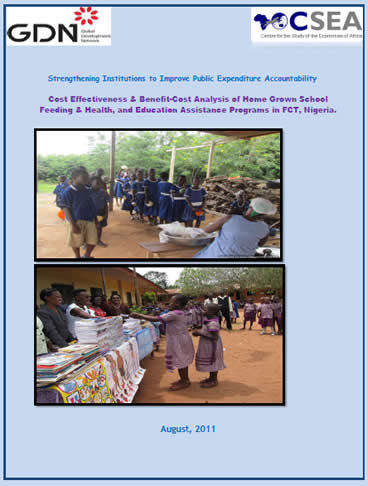Author:Eberechukwu Uneze &Ibrahim Tajudeen
Publication Date:August 2011
Document Size:41 pages
The Federal Government of Nigeria, in its effort to improve access to, and quality of primaryschool education, as a way of achieving the Millennium Developments Goals as well as ensuringEducation for All, introduced a series of programs in the education sector, including, but notlimited to the Home Grown School Feeding & Health program and the Education Assistanceprogram implemented in public primary school in the FCT, Nigeria. This report primarily conductsa Cost-Effectiveness analysis of Nigerias education sector with particular emphasis on the relativeeffectiveness and efficiency of HGSF&H and EA programs. However, it is complemented with aBenefit-Cost analysis. It proceeds with the analysis of the average cost of the education programs,and then moves on to the program CEA and the BCA. The cost per beneficiary shows that per pupilcost of HGSF&H program is approximately NGN8, 163 which is higher than the NGN5, 000 perpupil cost of EA program. This suggests that the EA program is more economical in reaching pupilsin FCT public primary school than the HGSF&H program that appears to be expensive.
The program CEA examines the relative cost and effectiveness of HGSF&H and EA programs.Following the challenges encountered in identifying a suitable effect measure and in accessingdata for estimating the effectiveness measure, the study used the probable impact of interventiondeveloped by Schiefelbein and Wolff (2007) as the effectiveness measure. Relying on thiseffectiveness measure, this study estimated the incremental unit costs of HGSF&H and EAprogram, and later derived their cost-effectiveness ratios. The analysis shows that the EA programis more cost-effective than the HGSF&H program. On the BCA, the findings show that, thoughboth programs are beneficial in monetary values, the EA program is more sustainable andbeneficial. This is evidenced by its high NPV and BenefitCost ratio.To determine the validity ofthe findings, a one-way (for CEA and BCA) and multi-way (for CEA only) sensitivity analyses – worstand best case scenarios were conducted. Overall, the results show that the EA program is moresuccessful, efficient and beneficial than the HGSF&H program.

